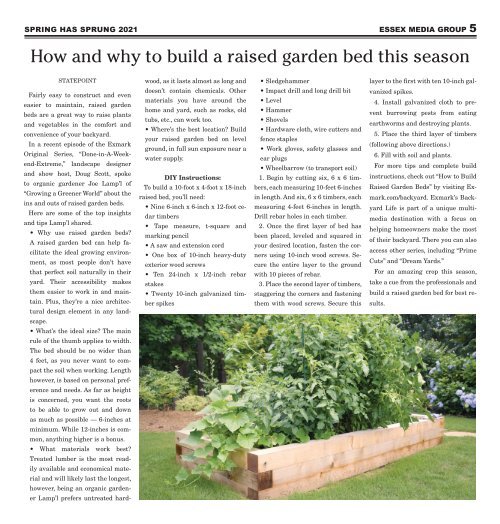You also want an ePaper? Increase the reach of your titles
YUMPU automatically turns print PDFs into web optimized ePapers that Google loves.
SPRING HAS SPRUNG <strong>2021</strong> ESSEX MEDIA GROUP 5<br />
How and why to build a raised garden bed this season<br />
STATEPOINT<br />
Fairly easy to construct and even<br />
easier to maintain, raised garden<br />
beds are a great way to raise plants<br />
and vegetables in the comfort and<br />
convenience of your backyard.<br />
In a recent episode of the Exmark<br />
Original Series, “Done-in-A-Weekend-Extreme,”<br />
landscape designer<br />
and show host, Doug Scott, spoke<br />
to organic gardener Joe Lamp’l of<br />
“Growing a Greener World” about the<br />
ins and outs of raised garden beds.<br />
Here are some of the top insights<br />
and tips Lamp’l shared.<br />
• Why use raised garden beds?<br />
A raised garden bed can help facilitate<br />
the ideal growing environment,<br />
as most people don’t have<br />
that perfect soil naturally in their<br />
yard. Their accessibility makes<br />
them easier to work in and maintain.<br />
Plus, they’re a nice architectural<br />
design element in any land-<br />
wood, as it lasts almost as long and<br />
doesn’t contain chemicals. Other<br />
materials you have around the<br />
home and yard, such as rocks, old<br />
tubs, etc., can work too.<br />
• Where’s the best location? Build<br />
your raised garden bed on level<br />
ground, in full sun exposure near a<br />
water supply.<br />
DIY Instructions:<br />
To build a 10-foot x 4-foot x 18-inch<br />
raised bed, you’ll need:<br />
• Nine 6-inch x 6-inch x 12-foot cedar<br />
timbers<br />
• Tape measure, t-square and<br />
marking pencil<br />
• A saw and extension cord<br />
• One box of 10-inch heavy-duty<br />
exterior wood screws<br />
• Ten 24-inch x 1/2-inch rebar<br />
stakes<br />
• Twenty 10-inch galvanized timber<br />
spikes<br />
• Sledgehammer<br />
• Impact drill and long drill bit<br />
• Level<br />
• Hammer<br />
• Shovels<br />
• Hardware cloth, wire cutters and<br />
fence staples<br />
• Work gloves, safety glasses and<br />
ear plugs<br />
• Wheelbarrow (to transport soil)<br />
1. Begin by cutting six, 6 x 6 timbers,<br />
each measuring 10-feet 6-inches<br />
in length. And six, 6 x 6 timbers, each<br />
measuring 4-feet 6-inches in length.<br />
Drill rebar holes in each timber.<br />
2. Once the first layer of bed <strong>has</strong><br />
been placed, leveled and squared in<br />
your desired location, fasten the corners<br />
using 10-inch wood screws. Secure<br />
the entire layer to the ground<br />
with 10 pieces of rebar.<br />
3. Place the second layer of timbers,<br />
staggering the corners and fastening<br />
them with wood screws. Secure this<br />
layer to the first with ten 10-inch galvanized<br />
spikes.<br />
4. Install galvanized cloth to prevent<br />
burrowing pests from eating<br />
earthworms and destroying plants.<br />
5. Place the third layer of timbers<br />
(following above directions.)<br />
6. Fill with soil and plants.<br />
For more tips and complete build<br />
instructions, check out “How to Build<br />
Raised Garden Beds” by visiting Exmark.com/backyard.<br />
Exmark’s Backyard<br />
Life is part of a unique multimedia<br />
destination with a focus on<br />
helping homeowners make the most<br />
of their backyard. There you can also<br />
access other series, including “Prime<br />
Cuts” and “Dream Yards.”<br />
For an amazing crop this season,<br />
take a cue from the professionals and<br />
build a raised garden bed for best results.<br />
scape.<br />
• What’s the ideal size? The main<br />
rule of the thumb applies to width.<br />
The bed should be no wider than<br />
4 feet, as you never want to compact<br />
the soil when working. Length<br />
however, is based on personal preference<br />
and needs. As far as height<br />
is concerned, you want the roots<br />
to be able to grow out and down<br />
as much as possible — 6-inches at<br />
minimum. While 12-inches is common,<br />
anything higher is a bonus.<br />
• What materials work best?<br />
Treated lumber is the most readily<br />
available and economical material<br />
and will likely last the longest,<br />
however, being an organic gardener<br />
Lamp’l prefers untreated hard-

















